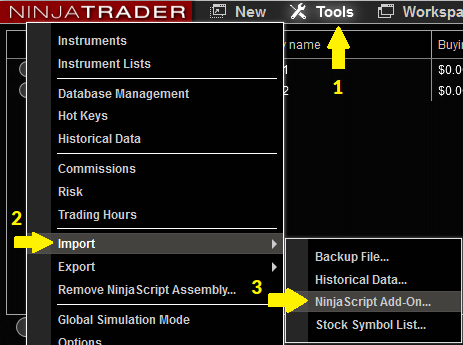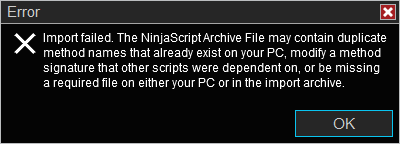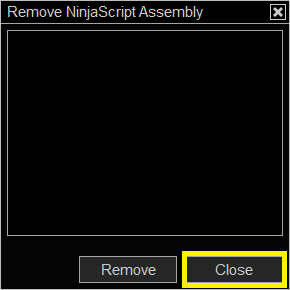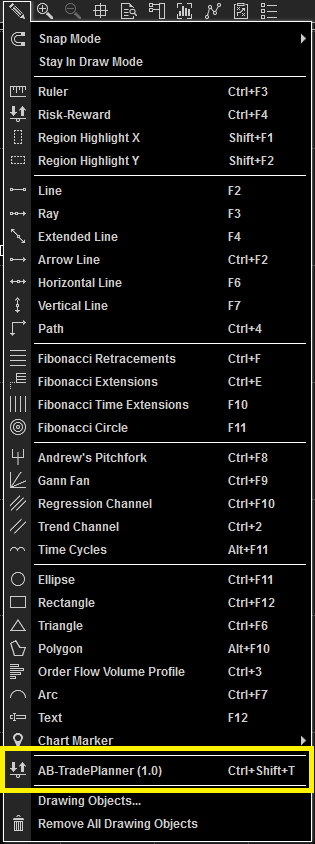This drawing tool is very straight-forward and works like virtually all other NinjaTrader drawing tools. Once installed, simply select 'AB-TradePlanner (version)' from the drawing tools drop-down menu to use it. Click once to set your entry price and click again to set your stop level. Click on either the entry or stop anchor and drag them around to move them and recalculate position size, risk and targets. If you double-click on any level you can access the drawing tool properties and customize it as you see fit. Remember to set templates to make your trade planning even faster and access your preferred settings quickly! I tried to give all the properties names that make sense and, if you hover over them with your mouse, I've included more detailed descriptions as appropriate. Overall, I don't think there's too much that's a mystery. However, this page will provide an overview just in case something doesn't make sense to you.
Download Instructions
You can download the latest version of AB-TradePlanner here . Make sure you save the file somewhere you can find it easily -- your Downloads folder or your Desktop are usually the easiest places. If you wish to verify your download, the SHA-256 checksum is displayed below the download button for each release on the Downloads page.
Installation, Upgrades & Removal
installation
Open NinjaTrader and go to the main control window (the one with the main program menu) and select Tools | Import | NinjaScript Add-On... [Installation screenshot 1]
Navigate and find the ZIP file you downloaded. Select it and click "Open". NinjaTrader will install the file for you.
Assuming there are no errors, you should see a dialog box saying "NinjaTrader successfully imported all scripts contained in the NinjaScriptArchive File." [Installation screenshot 2]
That's it, you're done!
upgrading
Upgrading involves removing the previous version and then installing the new version just as you did in the initial installation.
You MUST remove the previous version or NinjaTrader will fail to perform the upgrade. If you don't remove the previous version, you will see a dialog box saying "Import failed..." [Screenshot showing upgrade error]
Follow the steps in the "Uninstallation" section below to remove the current (old) version.
Now, follow the steps in the "Installation" section above to install the newest version. Just make sure you choose the newest ZIP (it will have the highest version number) and that will do the "upgrade" for you. Upgrading really is just installing the latest version. Your existing templates will be unaffected and will be automatically reapplied after the upgrade.
removal
It is recommended you remove any custom indicators from within NinjaTrader instead of deleting the file manually (though I've never experienced any problems manually deleting files). We will go through the recommended procedure here.
On the main NinjaTrader Control Center window (the one with the main program menu), select Tools | Remove NinjaScript Assembly [DLL uninstallation screenshot 1]
A new window will appear asking you to select which assembly you want to remove. Select ABTradePlanner_version (where '_version' is the currently installed version number) and click "Remove". [DLL uninstallation screenshot 2]
NinjaTrader will display a confirmation dialog box asking if you're sure. You are. Say Yes.
Assuming no errors, you will get a success message. Click OK to close the dialog box. [DLL uninstallation screenshot 3]
Click CLOSE on the "Remove NinjaScript Assembly" dialog box to close it. [DLL uninstallation screenshot 4]
AB-TradePlanner is now uninstalled. If you removed the indicator as part of the upgrade process, please follow the "Installation" section above to complete the upgrade.
Using In NinjaTrader
This drawing tool appears along with all other NinjaTrader drawing tools in the same 'pencil' drop-down menu. It follows the standard drawing tools usage rules, but, here's a more detailed breakdown:
adding to your chart
Open the drawing tools drop-down menu or open the context-menu and find AB-TradePlanner (version). [Screenshot of drawing tools menu]
Click to select the tool and change your cursor to a pencil. Left-click the mouse where you plan to enter your position then move your mouse to your planned stop level and left-click the mouse again. Your trade planner levels will be drawn automatically using the default template settings.
interaction
Clicking your entry or stop levels will display the associated anchor which you can click and drag to move. Your levels, risk and position size will update in realtime as your move either anchor point. Double-clicking on any level will open the properties grid. Right-clicking on any level will open the context menu which will allow you to open the properties grid or remove the drawing (you can also just press delete while the levels are selected to remove the drawing).
assigning a hot-key
If you want quick access to the drawing tool, you can assign it a hot-key:
In the NinjaTrader Control Center (main window), click on Tools | Hot Keys. [NinjaTrader Tools menu].
In the new window that opens, select Chart on the left side.
On the right side, scroll all the way down until you see AB-HZone (version). [Hot Keys dialog box].
Click on the empty box to the right and enter the hot-key combination you'd like to use for this drawing tool.
Click OK to close the dialog box and save your changes.
alerts
N.B. This feature will be implemented in a future version
Alerts are handled using the built-in NinjaTrader alerts system. Right-click on any level and select Alerts. This will bring up the NinjaTrader alerts dialog. More information about the alerts system can be found in the NinjaTrader official documentation . The alerts dialog is pretty complicated so you might find this YouTube video about NinjaTrader alerts or this YouTube video with some alert examples helpful.
Parameters
Click on any of the options below to expand it and read a more detailed explanation of what the particular parameter does. This section will be updated with each new release version.
position size
all levels
labels
entry level
stop level
risk line
target levels
1:1 level
contact me
Want to stay updated on new releases? Have questions or found a bug? Want to submit a feature request? Feel free to email me by clicking the button below. I'll be happy to answer any questions you have, help you get the indicator set-up, or let you know about incorporating your suggestion(s) into future versions. If you know how to program for NinjaTrader or in C#/.NET in general and want to contribute, email me using the button below or file an issue or pull request in the git repo (preferred).
email me










